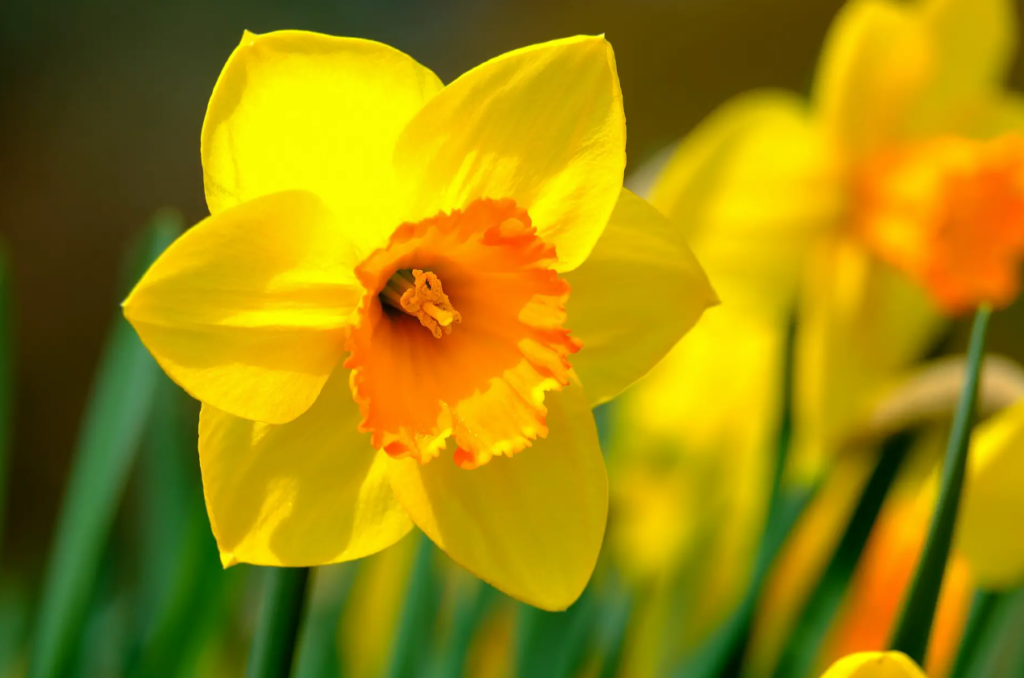Daffodils, scientifically known as Narcissus, are beautiful flowering plants belonging to the Amaryllidaceae family. With their vibrant hues and delicate petals, daffodils have captivated the hearts of gardeners, flower enthusiasts, and nature lovers for centuries. In this in-depth article, we will explore the origins, characteristics, cultivation, and cultural significance of daffodils. From their ancient history to the meaning of daffodils in different cultures, we will delve into the fascinating world of these stunning flowers.
Origins and Characteristics
Daffodils have a rich history that can be traced back thousands of years. Native to Europe, North Africa, and parts of Asia, these captivating flowers have enchanted people since ancient times. The name “daffodil” is derived from the Greek myth of Narcissus, a young hunter who fell in love with his own reflection and was transformed into a flower, forever immortalised as the daffodil.
Daffodils are renowned for their distinctive trumpet-shaped flowers, typically blooming in spring and heralding the arrival of a new season. They come in a wide array of colours, ranging from vibrant yellow, white, and orange to softer hues of pink and peach. The flowers consist of six petals arranged in a trumpet-shaped corona, which often contrasts with the surrounding perianth. The perianth can be either single or double, adding to the diversity of daffodil varieties. The leaves are slender and grass-like, emerging from a bulbous structure known as a bulb. These bulbs store energy and enable the plant to survive dormant periods.

Cultivation and Care
Daffodils are relatively easy to grow, making them a popular choice for gardeners and horticultural enthusiasts. Understanding their cultivation and care requirements is essential to ensure their optimal growth and blooming.
Location and Soil
Daffodils thrive in well-drained soil and prefer locations with full or partial sunlight. They can adapt to various soil types, but loose, loamy soil is ideal. If the soil is heavy or clayey, amending it with organic matter such as compost or well-rotted manure can improve drainage and nutrient availability.
Planting
Daffodil bulbs should be planted in autumn, allowing them to establish roots before the cold winter sets in. The bulbs should be planted at a depth of about two to three times their size, with the pointed end facing upward. It is recommended to plant them in clusters or drifts to create a visually stunning display. When selecting bulbs, choose firm and healthy ones, avoiding any that appear soft or diseased.
Watering and Fertilisation
Daffodils require regular watering, especially during their active growth period. However, they are sensitive to waterlogging, so the soil should not become excessively wet. Deep watering once a week is generally sufficient, ensuring the water reaches the root zone. Applying a balanced fertiliser in early spring can help promote healthy growth and abundant blooms. Use a slow-release fertiliser or apply a liquid fertiliser diluted according to the manufacturer’s instructions. Avoid over-fertilising, as it can result in excessive foliage growth at the expense of flowers.
Maintenance
After blooming, it is important to leave the foliage intact until it turns yellow. This allows the plant to photosynthesize and store energy in the bulbs for the next year’s growth. Avoid cutting back or tying the foliage as it withers naturally. As the foliage dies back, it can be gently pulled or cut away. Regular division of bulbs every three to four years can prevent overcrowding and enhance flower production. Lift the clumps of bulbs carefully using a garden fork or shovel, separate the offsets (smaller bulbs), and replant them in prepared soil. This division not only helps rejuvenate the plants but also allows for propagation and the creation of new daffodil patches.

Pests and Diseases
Daffodils are generally resistant to pests and diseases, making them relatively easy to maintain. However, there are a few common issues to watch out for. Bulb rot, caused by fungal pathogens, can affect the health of the bulbs. To prevent bulb rot, ensure proper soil drainage and avoid over-watering. Aphids can sometimes infest daffodils, sucking sap from the leaves and stems. These pests can be controlled by spraying the plants with a strong stream of water or by using insecticidal soap. Regularly inspect bulbs for signs of infestation and remove any affected bulbs promptly. If pest or disease problems persist, consult with local gardening resources for appropriate fungicides or insecticides.
Conclusion
Daffodils, with their radiant colours and graceful appearance, are a true wonder of nature. Whether planted in gardens, displayed in bouquets, or admired in artwork, these flowers continue to enchant people worldwide. Understanding their origins, cultivation, and cultural significance adds depth to the appreciation of daffodils. As we witness their vibrant blooms each spring, daffodils remind us of the beauty, resilience, and enduring hope that nature offers. Let us embrace the allure of daffodils and celebrate the enchanting world they bring to our lives.

Faye is a valuable contributor at Glenlivet Wildlife, with a degree in Botany and expertise in plants and flowers. She has embarked on expeditions to remote areas, interviewing renowned botanists and biologists to provide unique insights into flora worldwide. Her favourite flower is the Jade Vine, admired for its beautiful colour and delicate appearance.
